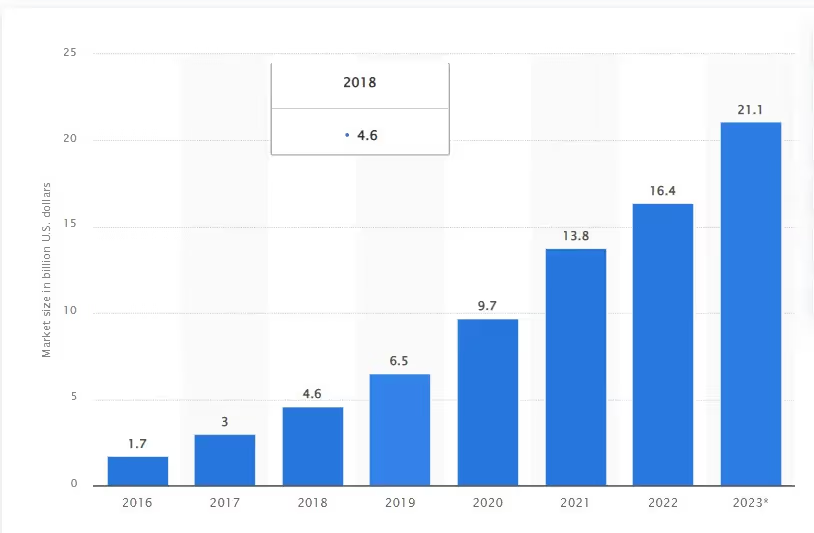Influencer marketing, a successful strategy embraced by countless businesses, connects companies with influential individuals who promote their brand. These trusted experts, with a dedicated online following, have a positive impact on consumers' purchasing decisions. In the digital era, influencer marketing has become essential for shaping consumer behaviour and raising brand awareness.
Influencer marketing platforms include celebrity influencers, micro influencers, nano influencers, and various other categorizations based on their audience size and reach.
Understanding influencer marketing statistics reveals its extensive reach to potential customers and impressive conversion rates. However, effectively managing influencers, tracking campaign performance, and combating fake followers require a strategic approach. Trust and authenticity are vital for influencer marketing success.
In this blog, we delve into how social media influencers contribute to brand growth, providing you with valuable insights and statistics. Learn about the power of influencer marketing and its influence on expanding brand visibility.
Evolution of Influencer Marketing
This industry has witnessed a remarkable evolution over the years, with significant growth and expanding opportunities. Let's explore the key milestones and trends that have shaped this dynamic industry.
1. Rapid Market Expansion
In 2016, the influencer marketing industry was valued at 1.7 billion dollars. And in 2023, it reached an impressive 21.1 billion dollars, indicating that influencer marketing expenditure has a substantial growth trajectory. The influencer marketing budget size has more than doubled since 2019, reflecting the increasing recognition and effectiveness of influencer campaigns.
2. Proliferation of Social Media Platforms
Among all the popular social media platforms, Instagram, in particular, remains the leading platform for influencer marketing. A recent survey highlighted its global popularity. Furthermore, the Instagram influencer market size exceeded two billion dollars for the first time in 2020.
3. Rise of Video-Based Platforms
While Instagram influencers dominate the influencer marketing landscape, video-based platforms like TikTok are gaining rapid popularity among marketers. The number of TikTok influencers soared from approximately 35.5 thousand in 2020 to over 106 thousand. The engaging nature of short videos on TikTok presents new opportunities for brand promotion, social media ads and audience engagement.
4. Diversification
Influencer programs have diversified to cater to different target audiences and brand objectives. Micro influencers, who have a smaller but highly engaged following, are gaining prominence. They offer niche expertise and authentic connections with their audience. This trend allows brands to tap into specific markets and cultivate loyal customer bases.
5. Emphasis on Transparency and Authenticity
In an era of increasing scrutiny, transparency and authenticity have become vital for successful influencer marketing campaigns. The industry is taking steps to combat issues like fake followers, ensuring that marketers collaborate with genuine influencers who have an authentic impact on their audience. Building trust is paramount for long-term brand-consumer relationships.
Next, we will delve into the effectiveness of influencer marketing, exploring how influencer marketing works its impact on brand growth and customer engagement.

Source: Statista
Is Influencer Marketing Effective?

Source: Mediakix
Influencer marketing campaigns have proven to be a highly effective strategy, with 80% of marketers finding it valuable. Its effectiveness is evident in driving quality traffic, boosting social media following and engagement, delivering comparable or better influencer marketing ROI, and the growing allocation of budgets. By incorporating unique discount vouchers, influencers can drive conversions and enhance customer quality.
Additionally, influencer marketing surpasses other channels in terms of ROI, with 89% of marketers finding it comparable or better. The success of effective influencer marketing strategy has led to increased budget allocations, with 65% of marketers planning to increase their budgets. Discover the top influencer marketing statistics to gain further insights.
With the effectiveness of social media marketing, it is essential to explore the top influencer marketing statistics to gain deeper insights into this dynamic strategy.
20 Influencer Marketing Statistics to Know
The Influencer Marketing Landscape
In 2022, the influencer generated content market in the United States witnessed remarkable growth, reaching an unprecedented valuation of 16.4 billion USD. It is noteworthy that 25% of marketers are currently leveraging influencer marketing strategies, tapping into the potential of influencers and their vast network of followers.
This trend is reinforced by the fact that 72% of Generation Z and Millennials actively follow influencers on various social media platforms, indicating their interest and engagement with influencer-generated content. Moreover, it is important to highlight that 89% of marketers currently engaged in influencer marketing have expressed their intention to increase or maintain their investment in this domain throughout 2023.
Influencer Marketing presence
Influencer marketing strategy is a form of user oriented customised content tailored to suit different social media platforms, 90% are active on Instagram, TikTok's popularity is rising. Marketing campaigns leveraged by influencers hinge on goals, compensation, follower count, engagement, and content quality, as exposed in an Emplifi survey.
Penetration
More than 60% of companies invested in influencer campaigns in 2020, affirming its business popularity. Nearly 40% of B2B marketers intend to boost their influencer campaigns usage, signalling its growing significance (Statista).
Influence on Consumer Behaviour
80% of consumers reportedly purchase after an influencer endorses a product on social media, underlining the impact on consumer behaviour (Oberlo). Word-of-mouth and social media are key in over 50% of consumer brand discovery, underscoring influencer marketing's role in brand discovery.
Influencer Marketing Platform-Benefits for Marketers
Influencer marketing assists 51% of marketers in securing superior customers by projecting brands to potential consumers. Content generated by influencers outperforms brand posts, affirming belief of 60% marketers in terms of follows, engagement, and conversions (Linqia).
ROI from Influencer Marketing
Influencer marketing offers 11 times more return on investment (ROI) than banner ads, manifesting its efficacy. Influencer recommendations compel 8 out of 10 consumers to purchase, indicating the trust placed in favourite creators (Linqia).
Influencer marketing Landscape on Instagram, Youtube, Tiktok, Facebook
Instagram and TikTok in Influencer Marketing
Instagram marketing hub reigns supreme in influencer marketing due to opportunities for post sharing on main feed and Stories (Linqia). In 2022, 45% of marketers leveraged TikTok for influencer marketing campaigns, predicted to surge by 4% in 2023. Macro influencers on TikTok (100,000-1 million followers) average 38,517 views per video. Up to 60% more engagement is generated by micro influencers than by macro-influencers.
Audience engagement
Instagram sees an average micro influencer engagement rate of 3.86% and an average mega-influencer engagement rate of 1.21%. These figures reflect the differing levels of audience engagement based on influencer size. The influencer marketing agencies actively look for new influencers so that they always have creative manpower for every niche.
YouTube Influencer Marketing
28% of US consumers follow at least one virtual influencer on YouTube. YouTube leverage influencer marketing excelled in dance, music, and gaming categories in 2021. Micro influencers on YouTube (100,000-1 million followers) display the highest engagement rates. YouTube was the preferred platform for watching gaming influencers in the US and Great Britain in 2021. (Hubspot)
YouTube exhibits an average micro influencer engagement rate of 1.64% and an average mega-influencer engagement rate of 0.37%. (Hubspot)
In 2021, the minimum average price per sponsored post from a YouTube mega-influencer (someone with 1 million or more followers globally) was $2,500. (Hubspot)
Facebook Influencer Marketing
52% of marketers employed Facebook for influencer marketing campaigns in 2022. Influencer videos represented 60% of video views on Facebook in the US in 2022 (Statista). Marketers allocated 10-20% of their marketing budget to influencer marketing in 2022 (Statista).
Influencer Marketing Hub: Investment and Returns
Businesses receive an average return of $6.50 for every dollar invested in an influencer marketing hub. In the US, spending on influencer marketing climbed from 3.69 billion to 4.14 billion in 2022 (Statista).
Influencer Marketing budgets
The average price for a post from TikTok mega influencers (1+ million followers) was $1,034 in 2021. An Instagram mega-influencer (1+ million followers) charged a minimum average price of $1,200 per post in 2021 for its target audience (Statista). The minimum average price per sponsored video from a YouTube mega-influencer (1+ million followers) was $2,500 in 2021 (Statista).
Tiktok Influencer marketing
Influencer posts on Tiktok boast an impressive average micro-influencer engagement rate of 17.96%, along with an average mega-influencer engagement rate of 4.96%.
How Phyllo can help with influencer marketing
Phyllo offers a powerful solution for influencer marketing, empowering brands with trusted creator data. With access to 100% authentic and updated creator data, brands can discover the right influencers and build strong partnerships.
Phyllo streamlines the influencer onboarding process, allowing for quick and efficient onboarding from multiple social platforms. By categorising creators, brands can target the right influencers for brand collaborations and affiliate marketing. With accurate measurement of ROI, engagement, and campaign success across platforms, Phyllo helps brands measure what truly matters in their influencer marketing efforts.
Final Take
Influencer marketing has become an essential strategy for businesses to connect with influential individuals who promote their brands on a social media platform. With the power of influencer-generated content and the engagement of their followers, influencers have a significant impact on consumer behaviour and brand awareness.
The evolution of this industry is evident in its rapid market expansion, the proliferation of social media platforms, the rise of video-based platforms like TikTok, diversification of influencer programs, and the emphasis on transparency and authenticity.
Understanding influencer marketing statistics reveals its extensive reach, effectiveness, and return on investment. However, managing influencers, tracking campaign performance, and combating fake followers require a strategic approach. Trust and authenticity remain crucial for successful influencer marketing.
The influencer marketing landscape is vast, spanning across popular platforms such as Instagram, TikTok, YouTube, and Facebook, each offering unique advantages and levels of engagement. However, with Phyllo, brands gain a powerful advantage. By harnessing reliable creator data, simplifying onboarding procedures, precisely targeting suitable influencers, and accurately measuring the impact of their influencer marketing campaigns, Phyllo empowers brands to maximize their influencer marketing efforts.
If you're ready to revolutionise your influencer marketing strategy, click here to request a demo. Experience the future of influencer marketing with Phyllo and witness how it shapes consumer behaviour, fuels brand growth, and fosters unparalleled customer engagement in the digital era.









